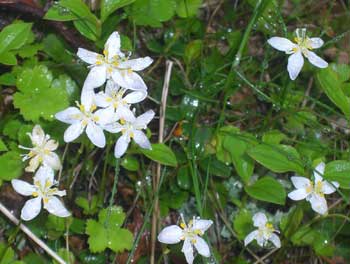Contents:
Common Names | Parts Usually Used | Plant(s) & Culture | Where Found | Medicinal Properties
Legends, Myths and Stories | Uses | Formulas or Dosages | Bibliography
Scientific Names

- Coptis trifolia L.
- Coptis groenlandica L.
- Buttercup family
Common Names
- Canker root
- Huang-lien (Chinese name)
- Mouthroot
- Vegetable gold
- Yellowroot
Parts Usually Used
Rootstock, dried
Back to Top
Description of Plant(s) and Culture
Goldthread is a low, small, perennial plant; from a slender, golden, creeping rootstock arise the basal, long-petioled, trifoliate, shiny evergreen leaves, each with three toothed leaflets, and the naked scapes, 3-6 inches high, which terminate in a small, white flower. Each flower has 5-7 petals and many stamens. Flowering time is May to August. The fruit is an oblong capsule or pod-like.
Another plant called Yellow root (Xanthorhiza simplicissima) is of the buttercup family also.
Back to Top
Where Found
Found in mossy, cool, woods and swamps from Labrador south to Maryland and west to Minnesota, Iowa, and Tennessee. Also in Canada, Iceland, Siberia, and India.
Back to Top
Medicinal Properties
Bitter tonic, antiphlogistic, sedative
Back to Top
Legends, Myths and Stories
The plant gets its name from the threadlike, bright yellow roots. The yellow color comes from the berberine alkaloid. And, of course, the name canker root came from the fact that the herb treats canker sores.
The Native Americans and the colonists used the gold thread herb for any soreness in the mouth, but it is very bitter.
Back to Top
Uses
Has been used internally as a bitter tonic, particularly for dyspepsia. Its main use has been as a wash or gargle for sores and ulcerations in the mouth, jaundice, throat, and even stomach. It has been a popular folk remedy for inflammations of mucous membranes in the mouth and around the eyes. It is said to help people combat the craving for alcohol. Improves appetite and was given to children for thrush. Contains berberine; anti-inflammatory and antibacterial. Used in the treatment of alcoholism.
Back to Top
Formulas or Dosages
Collect the rootstock in the fall.
Decoction: boil 1 tsp. rootstock in 1 cup water. Take 1 tbsp., 3-6 times a day; or use as a wash or gargle. Rootstock also may be chewed to alleviate mouth sores.
Tincture: take 5-10 drops at a time.
To make a tincture, place 1 oz. of the cut root in a pint of good brandy. Cap tightly and let it stand for 1 week, shaking the bottle once or twice a day. Strain. Dose: 1 tsp. in 1/2 glass water 3 times a day.
Back to Top
Bibliography
![]() The Herb Book
The Herb Book, by John Lust, Bantam Books, 666 Fifth Avenue, New York, NY. copyright 1974.
![]() Back to Eden
Back to Eden, by Jethro Kloss; Back to Eden Publishing Co., Loma Linda, CA 92354, Original copyright 1939, revised edition 1994
![]() Eastern/Central Medicinal Plants
Eastern/Central Medicinal Plants, by Steven Foster and James A. Duke., Houghton Mifflin Company, 215 Park Avenue South, New York, NY 10000
![]() The Herbalist Almanac
The Herbalist Almanac, by Clarence Meyer, Meyerbooks, publisher, PO Box 427, Glenwood, Illinois 60425, copyright 1988, fifth printing, 1994
![]() Chinese Medicinal Herbs
Chinese Medicinal Herbs, compiled by Shih-Chen Li, Georgetown Press, San Francisco, California, 1973.
![]() Indian Herbalogy of North America
Indian Herbalogy of North America, by Alma R. Hutchens, Shambala Publications, Inc., Horticultural Hall, 300 Massachusetts Avenue, Boston, Massachusetts 02115, 1973
![]() American Folk Medicine
American Folk Medicine, by Clarence Meyer, Meyerbooks, publisher, PO Box 427, Glenwood, Illinois 60425, 1973
![]() Webster’s New World Dictionary
Webster’s New World Dictionary, Third College Edition, Victoria Neufeldt, Editor in Chief, New World Dictionaries: A Division of Simon & Schuster, Inc., 15 Columbus Circle, New York, NY 10023
 How Indians Use Wild Plants for Food, Medicine & Crafts
How Indians Use Wild Plants for Food, Medicine & Crafts, by Frances Densmore, Dover Publications, Inc., 180 Varick Street, New York, NY 10014, first printed by the United States Government Printing Office, Washington, in 1928, this Dover edition 1974
 An Instant Guide to Medicinal Plants
An Instant Guide to Medicinal Plants, by Pamela Forey and Ruth Lindsay, Crescent Books (January 27, 1992).
 Old Ways Rediscovered
Old Ways Rediscovered, by Clarence Meyer, Meyerbooks, publisher, PO Box 427, Glenwood, Illinois 60425, published from 1954, print 1988
 Secrets of the Chinese Herbalists
Secrets of the Chinese Herbalists, by Richard Lucas, Parker Publishing Company, Inc., West Nyack, NY, 1987.
![]() The Yoga of Herbs: An Ayurvedic Guide to Herbal Medicine
The Yoga of Herbs: An Ayurvedic Guide to Herbal Medicine, by Dr. David Frawley & Dr. Vasant Lad, Lotus Press, Twin Lakes, Wisconsin, Second edition, 1988.
 The Rodale Herb Book: How to Use, Grow, and Buy Nature’s Miracle Plants (An Organic gardening and farming book)
The Rodale Herb Book: How to Use, Grow, and Buy Nature’s Miracle Plants (An Organic gardening and farming book), edited by William H. Hylton, Rodale Press, Inc. Emmaus, PA, 18049., 1974
